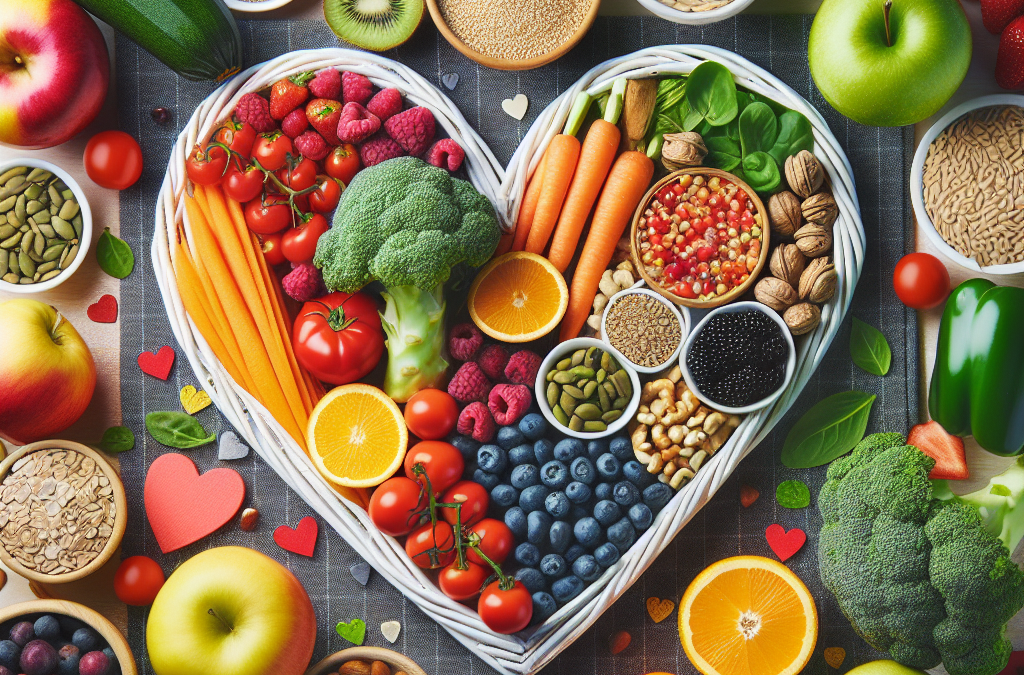Fatty Fish
Why Fatty Fish is Essential
When it comes to heart health, fatty fish like salmon, mackerel, and sardines are just about the best thing you can chow down on. Rich in omega-3 fatty acids, these fish help lower triglycerides and maintain a healthy blood pressure. In my journey towards a healthier lifestyle, incorporating fatty fish has been a game-changer.
Not only does it contribute to reducing the risk of heart disease, but it also packs a punch in terms of flavor! I remember the first time I grilled salmon with a little lemon and dill – I was absolutely hooked.
Easily incorporated into meals, I often make a batch of fish tacos or a hearty salmon salad. The possibilities are endless, and your heart will thank you.
How to Pick the Right Fatty Fish
Choosing the right fatty fish can feel overwhelming given the variety available. I always look for fresh, wild-caught options whenever possible. They not only taste better but are also richer in nutrients compared to farmed versions.
Look into your local markets or fresh seafood shops, and don’t shy away from asking questions. I’ve had some great recommendations from fishmongers that introduced me to new recipes I’d never considered before.
If you’re not a fan of fish, don’t sweat it! There are plenty of omega-3 supplements out there, but I prefer getting my nutrients from food whenever I can.
Cooking Tips for Fatty Fish
Now that you’ve chosen your fish, let’s talk about cooking. I think grilling is one of the best methods – it brings out the natural flavors and results in a lovely texture. When grilling, I always marinate mine to add an extra layer of flavor.
Another easy way to prepare fatty fish is baking. Just pop it in the oven with some herbs and veggies, and you’ve got a simple, healthy meal ready in no time.
As long as you’re mindful about cooking temperatures, you can’t go wrong. I’ve had some ‘oops’ moments when cooking but the beauty of cooking is it’s always a learning experience!
Berries
Benefits of Berries for Heart Health
Berries like blueberries, strawberries, and raspberries are not only delicious but also packed with antioxidants known as flavonoids. These compounds help reduce blood pressure and inflammation, two major players in heart health.
I’ll often toss berries into my morning oatmeal or yogurt for breakfast. It’s a tasty way to pack in extra nutrients. Plus, who doesn’t love a vibrant splash of color in the morning?
They’re also fantastic for snacking – just grab a handful and you’re good to go. I always feel like I’m indulging in something sweet, but with a healthy twist!
How to Incorporate Berries into Your Diet
Getting berries into your meals doesn’t have to be a chore. I enjoy blending them into smoothies, which is a slick way to boost my nutrient intake without even noticing it.
If you’re baking, swap out regular sugar for some berry puree in cakes or muffins. Not only does it add flavor, but it gives your treats a health kick too!
And let’s not forget about salads. Berries, especially strawberries, can elevate a simple spinach salad from bland to beautiful. Just toss them in, add some nuts, and a drizzle of balsamic vinaigrette, and you’ve got a winner!
Buying Tips for Fresh Berries
When shopping for berries, I always make sure they are firm and vibrant – dull-colored ones can be a sign they’re past their prime. Check for mold or mushiness, as that’s a telltale sign to steer clear.
Don’t hesitate to visit local farmers’ markets, where you’re likely to find fresher options than at big grocery stores. I love chatting with the vendors about their growing practices – it adds a personal touch!
And if you can’t finish them all in time, freeze them! They freeze beautifully and can be used in baking or smoothies later.
Nuts and Seeds
The Heart-Healthy Fats in Nuts
Let’s talk about nuts and seeds – these little guys are like the superheroes of heart-healthy eating! Almonds, walnuts, flaxseeds, and chia seeds are rich in unsaturated fats that promote good heart health.
A handful of nuts in my snack routine has increased my energy level in such a noticeable way. Plus, they keep me full between meals, which has definitely helped my snacking habits.
I often sprinkle flaxseeds on my cereal or salads. It’s an easy way to tweak my meals to make them even healthier without much effort.
How to Choose the Right Nuts
When choosing nuts, I personally go for raw or dry roasted varieties – that way, I avoid unhealthy oils and added sugar that some flavored nuts might sneak in.
And hey, if you’re not a fan of munching on them whole, that’s cool too! You can find nut butters made from just nuts and maybe a dash of salt. Slam some on whole-grain bread, and you’ve got yourself a killer snack!
Always check the ingredient list; you’ll be surprised how many nut products contain additives. Keeping it simple is best.
Snack Ideas with Nuts and Seeds
Need some inspo? I love making trail mix using a mix of my favorite nuts and seeds, adding some dark chocolate chunks for a bit of sweetness. It’s my go-to for hikes or long drives!
Or, if I’m feeling extra, I whip up some energy balls with peanut butter, oats, honey, and seeds. Just mix, roll into balls, and you have a quick snack that’s totally satisfying.
Get an Amazing Discount on the Best Certified Organic Whole Food Supplement!
These options always leave me feeling great, and they’re super easy to make ahead of time, which is a huge bonus.
Leafy Greens
Health Benefits of Leafy Greens
Don’t overlook the power of leafy greens like spinach, kale, and Swiss chard! Loaded with vitamins, minerals, and antioxidants, they’re essential for keeping your heart healthy.
Having a salad almost daily has improved my overall health. It’s a refreshing way to get those greens in while also feeling satiated and energized.
Plus, the fiber content helps with digestion and keeps your cholesterol levels in check. Who knew eating your greens could be so beneficial?
How to Incorporate Leafy Greens into Meals
Adding leafy greens to your meals is easier than you might think! I love sautéing spinach with garlic as a quick side that pairs nicely with almost anything.
Or try blending kale into your morning smoothie. Honestly, you won’t even taste it! It’s a sneaky way to boost nutrition without altering the flavor.
Another quick hack is to throw a handful of greens into soups or stews. It adds bulk and nutrition without requiring loads of effort. Win-win!
Tips for Selecting Fresh Greens
When selecting leafy greens, I make sure to choose ones that are vibrant and crisp. Wilted or yellowing leaves aren’t worth your time – they won’t offer the same nutrients!
If you have access to local farmers’ markets, you’ll often find fresher options there compared to supermarkets. Connecting with local farms brings another level of enjoyment to your meals.
Store your greens in a breathable container to help them last longer in the fridge. Oh, and always wash them before using – you never know what might be lingering on those leaves!
Whole Grains
Why Whole Grains Matter
Whole grains like oats, quinoa, and brown rice are a vital part of a heart-healthy diet. They’re packed with fiber which helps lower cholesterol and keeps blood sugar levels stable.
Since incorporating more whole grains into my meals, I’ve noticed a significant boost in energy and satisfaction after eating. It’s a way to feel fuller longer without overstuffing myself.
Plus, whole grains come with a variety of flavors and textures, making them super versatile for all sorts of meals. I love experimenting with different grains in my cooking!
Incorporating Whole Grains in Your Meals
Making the switch to whole grains is straightforward. Start your day with oatmeal instead of sugary cereals. You’ll find it’s a filling and nutritious start to your morning!
Quinoa and brown rice can easily replace their white counterparts in any dish too. I love using quinoa as a base for grain bowls topped with veggies and proteins.
Simple swaps like these can make a massive difference without changing how you eat. Your body will start to love you for it over time!
Selecting the Best Whole Grains
When shopping for whole grains, always check the ingredients to ensure that “whole” is listed first. I’ve made the mistake of grabbing bags marked “multigrain” that still had plenty of refined grains.
Experiment with different types of grains to see which you prefer. Sometimes, I’ll mix grains together in a dish for varying textures and flavors!
Also, look for bulk bins in health food stores. They often have options at better prices, and you can buy just what you need!
Conclusion
Incorporating these superfoods into your diet doesn’t have to feel overwhelming. Start small, add some berries to your breakfast, bake a piece of fatty fish, or throw leafy greens into your next meal. Remember, every little bit helps, and making gradual changes is key to long-term health.
Your heart will appreciate the effort, and before you know it, these foods will become a regular, enjoyable part of your routine. So go on, get out there, and start mixing it up!
FAQ
1. How often should I eat fatty fish for heart health?
It’s generally recommended to eat fatty fish at least twice a week to reap the heart health benefits from omega-3 fatty acids.
2. Can I eat frozen berries instead of fresh?
Absolutely! Frozen berries are just as nutritious and can be used in smoothies, toppings, or baking.
3. Are nuts and seeds high in calories?
Yes, they are calorie-dense, but they are also packed with nutrients. Moderation is key – a small handful is a great snack!
4. Can I get enough vitamins from leafy greens alone?
While leafy greens are nutrient-rich, it’s best to eat a variety of foods to cover all your vitamin needs. Aim for a colorful plate!
5. What’s the best way to include whole grains in my diet?
Start by replacing refined grains with whole grains. Opt for brown rice, whole wheat bread, or quinoa and see what suits your palate best!




